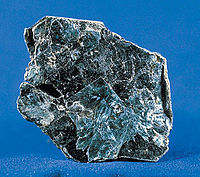
Photo from wikipedia
We present 275 new metal-silicate partition coefficients for P, S, V, Cr, Mn, Co, Ni, Ge, Mo, and W obtained at moderate P (1.5 GPa) and high T (1683–1883 K). We investigate… Click to show full abstract
We present 275 new metal-silicate partition coefficients for P, S, V, Cr, Mn, Co, Ni, Ge, Mo, and W obtained at moderate P (1.5 GPa) and high T (1683–1883 K). We investigate the effect of silicate melt composition using four end member silicate melt compositions. We identify possible silicate melt dependencies of the metal-silicate partitioning of lower valence elements Ni, Ge and V, elements that are usually assumed to remain unaffected by changes in silicate melt composition. Results for the other elements are consistent with the dependence of their metal-silicate partition coefficients on the individual major oxide components of the silicate melt composition suggested by recently reported parameterizations and theoretical considerations. Using multiple linear regression, we parameterize compiled metal-silicate partitioning results including our new data and report revised expressions that predict their metal-silicate partitioning behavior as a function of P-T-X-fO2. We apply these results to constrain the conditions that prevailed during core formation in the angrite parent body (APB). Our results suggest the siderophile element depletions in angrite meteorites are consistent with a CV bulk composition and constrain APB core formation to have occurred at mildly reducing conditions of 1.4 ± 0.5 log units below the iron-wustite buffer (ΔIW), corresponding to a APB core mass of 18 ± 11%. The core mass range is constrained to 21 ± 8 mass% if light elements (S and/or C) are assumed to reside in the APB core. Incorporation of light elements in the APB core does not yield significantly different redox states for APB core-mantle differentiation. The inferred redox state is in excellent agreement with independent fO2 estimates recorded by pyroxene and olivine in angrites.
Journal Title: Geochimica et Cosmochimica Acta
Year Published: 2017
Link to full text (if available)
Share on Social Media: Sign Up to like & get
recommendations!